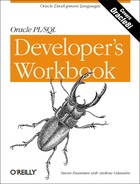Chapter 1. Declaring Variables and Naming Elements
Beginner
Intermediate
Q: | |
1-7. | Use the %TYPE anchoring attribute against a PL/SQL variable, just as you would anchor to the column of a table: CREATE OR REPLACE PACKAGE types IS dollar_amount NUMBER(20,2); END; / DECLARE my_dollars types.dollar_amount%TYPE; BEGIN ... END; |
Q: | |
1-8. | The statements about the DATE datatype are:
|
Q: | |
1-9. | The thing to remember when using a SUBTYPE is that you do not include a %TYPE anchoring attribute. A subtype already is a type. Here is the solution: CREATE OR REPLACE PACKAGE types IS SUBTYPE dollar_amount_t IS NUMBER; END; / DECLARE my_dollars types.dollar_amount_t; BEGIN ... END; |
Q: | |
1-10. | You can’t anchor (use %TYPE) against a CONSTANT; it must be a variable. |
Q: | |
1-11. | Unlike the folks who wrote the PL/SQL language, we developers are not allowed to “constrain” our own SUBTYPEs. In other words, after the IS keyword you cannot supply a datatype declaration that limits the size or length explicitly. Note that this restriction is relaxed in Oracle8i . |
Q: | |
1-12. | You receive this error: ORA-06502: PL/SQL: numeric or value error because a variable assigned the type SIGNTYPE can have only one of three values: –1, 1, or NULL. |
Q: | |
1-13. | Statements (b) and (c) both describe the value of anchoring. |
Q: | |
1-14. | You can anchor to a table, a view, a column in a table or view, a cursor, or a scalar PL/SQL variable. |
Q: | |
1-15. | One would hope that this function returns a BOOLEAN, as in: FUNCTION is_value_in_list (list IN VARCHAR2, value IN VARCHAR2) RETURN BOOLEAN; Oracle Forms documentation for the GET_GROUP_CHAR_CELL function unfortunately offers an example program named is_value_in_list that returns a number. If you name programs inaccurately, developers will have a much harder time understanding and using those programs. |
Expert
Q: | |
1-16. | THEN is a reserved word; the PL/SQL compiler refuses to interpret it as a variable name. SYSDATE, on the other hand, is not a reserved word. Rather, it is a function declared in the STANDARD package, one of the two default packages of PL/SQL. You could write that block in an even more confusing manner, just to drive home the difference between “your” sysdate variable and the STANDARD’s SYSDATE function: DECLARE
sysdate DATE;
BEGIN
sysdate := sysdate;
DBMS_OUTPUT.PUT_LINE ('Date is ' || sysdate);
sysdate := STANDARD.SYSDATE;
DBMS_OUTPUT.PUT_LINE ('Date is ' || sysdate);
END;You will see this output: Date is Date is 24-JAN-99 As explained in 1-11, we developers are not allowed to constrain our own SUBTYPEs. In other words, you cannot supply after the IS keyword a datatype declaration that limits the size or length explicitly. Check out $ORACLE_HOME/RdbmsNN/admin/standard.sql (the file that creates the PL/SQL STANDARD package) for examples of constrained SUBTYPEs. |
Q: | |
1-17. | The following block of code raises a VALUE_ERROR exception when executed. It demonstrates the technique of constraining a SUBTYPE: DECLARE primary_key NUMBER(6); SUBTYPE primary_key_t IS primary_key%TYPE; mypky primary_key_t; BEGIN mypky := 11111111; END; What you’ve done is a sleight-of-hand maneuver. You want the SUBTYPE declaration to look like this: SUBTYPE primary_key_t IS NUMBER(6); But that code will be rejected by the compiler. Instead, you must declare a variable with the appropriate constraint and then reference that variable with a %TYPE in your SUBTYPE statement. The subtype then inherits the constraint. |
Q: | |
1-18. | Here are three rules to keep in mind when working with NULLs:
|
Q: | |
1-19. | These operators allow you to work with NULLs in a structured way: |
